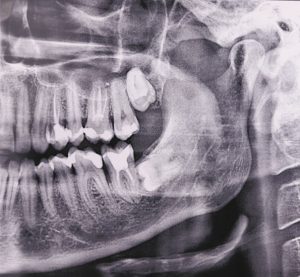By Dr. Amanda Rizner


Dental radiographs or x-rays are a type of electromagnetic radiation and are commonly measured by a unit called the Sievert. In dosage norms, the typical individual will receive amounts in the milli Sievert range per year (1/1000 Sievert). On average, each person will receive somewhere between 3-10 millisieverts yearly depending on their circumstances. Factors such as where you live, what your occupation is and how many medical procedures you may undergo can contribute to this dosing. A common recommendation is that radiation is safe when staying below 30-50 milliSieverts per year.
The dental dosage of radiation can vary depending on the type of x-ray, but it generally falls in the range of 5 to 10 microSieverts per x-ray (1/1000 of a millisievert). To further contextualize, consider that a panoramic x-ray (usually taken once every 5 years) will deliver 10 microsieverts and a bite-wing or a periapical x-ray (usually taken at your yearly checkup exam) anywhere from 2 to 5 microsieverts. In contrast, the average annual background radiation exposure from natural sources throughout the year is approximately 2 to 3 microSieverts (1,000x an annual dental x-ray). This background radiation is largely unavoidable. It is a present everywhere on earth meaning that we will all experience it no matter what we do. Consider that a new study from the American Academy of Oral and Maxillofacial Radiology was recently published stating lead aprons are no longer needed on patients, even those pregnant or with history of thyroid cancer, due to the negligible amount of radiation passed during routine digital dental xrays to the patient.
Furthermore, the location we live and our occupation are often the largest sources of radiation. Flying by airplane can also be a large consideration adding anywhere from 0.1-1 milliSieverts. Medical radiation, including diagnostic and therapeutic procedures like CT scans, can contribute significantly to an individual’s annual radiation dose. A single CT can expose a patient to around 10 milliSieverts or more.
Our recommendation is that individuals that are concerned about radiation track how much they are receiving each year. This can be done by estimating their occupational health risks, where they live and how much air travel they do, and how many medical grade CT or other radiation tests they accumulate. These are the largest areas of radiation accumulation. Each individual must weigh the tradeoffs of their radiation accumulation and decide to avoid or decline dental x-rays, which end up being a very trivial amount in the end.
In conclusion, dental, x-rays are a valuable tool in dentistry and their radiation exposure is exceedingly low compared to background natural radiation. While it’s essential to minimize unnecessary exposure to radiation, the risk associated with dental x-rays is relatively negligible when used in accordance with professional guidelines. Patients should always communicate their concerns with their healthcare providers to ensure the appropriate use of these diagnostic tools.
(941) 529-0055
www.dentistryonfruitville.com
 Southwest Florida's Health and Wellness Magazine Health and Wellness Articles
Southwest Florida's Health and Wellness Magazine Health and Wellness Articles

